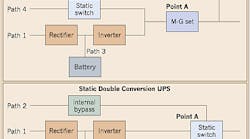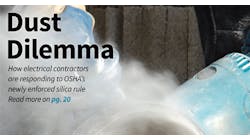Selecting a UPS System for Critical Power Applications
Rotary or static? That's the question
When considering a UPS system for specific critical power applications, you may be surprised to learn that you have more than a handful of options these days. Units are now available in several configurations, so it's useful to compare basic topology and operating principles of various systems that are commonly specified for critical applications. Your biggest decision will be between static and rotary systems, both of which are suitable for critical power applications. Among static UPS systems, the online, double-conversion system is the closest to the hybrid rotary UPS system in terms of design and operation, and thus provides a useful basis for comparison between the rotary and static technologies. Not all static UPS systems available on the market are exactly alike, but the principles outlined below are common to most systems.
The Figure at right shows the principle building blocks of the two types of UPS systems, drawn on an equivalent basis in terms of major elements and conducting paths. The hybrid rotary UPS system incorporates two fully rated power paths that provide conditioned power to the load, while the static UPS system has one.
In the hybrid rotary UPS, the dual SCR bridge, 12-pulse rectifier provides current to the inverter when needed and simultaneously maintains the batteries at their full rated charge. Normally, the thyristor switch and motor-generator supplies the load, which provides regulated output voltage over a ±8% input range. When the main power source fails or is interrupted, the battery operation phase begins. As the output of the rectifier decreases, the battery supports the DC bus voltage and corresponding input to the inverter. The 6-pulse inverter is switched on to maintain power to the load by feeding the motor-generator directly, which, in turn, maintains a constant voltage to the load.
Similar to static UPS systems, the phase-controlled SCR inherently prevents battery current from flowing back into the main supply. In addition, the batteries support the inverter until the main power is restored. Unlike that of the static UPS, however, the inverter of the hybrid rotary UPS is off during normal operation, which means that the battery isn't subjected to the continuous AC currents caused by inverter switching.
In contrast to static UPS technology, which uses a single UPS power path that must operate continuously, the two-path design of a hybrid rotary UPS system allows it to operate from two independent power sources. In the hybrid rotary design, battery operation occurs only if both power sources fail. This can greatly reduce the number of battery discharges and increase battery life.
Because of power electronic component sizing, as well as the motor generator thermal withstand and energy storage, the hybrid rotary UPS design has greater overcurrent capability. Compared with the output of a static UPS that has a controlled inverter current limitation of about 2.5 to 3 times Inominal, the rotary machine output of the hybrid rotary UPS can typically deliver as much as 14 times Inominal inherently. This is particularly important in fault clearing circumstances, such as certain overloads or short circuits, and allows maintenance of full UPS function under these conditions.
Comparison of design features. When specifying a UPS system for critical power applications, review the following design features that are essential to ensuring the security of the system. Overload. Hybrid rotary UPS systems are designed with a high overload capability, which allows for large intermittent loading of the system without going to bypass. If a power utility failure results in the shutdown of one module of a 3-module, non-redundant system, each of the remaining hybrid rotary UPS modules can carry 150% load for 2 min. This is enough time to automatically start, synchronize, and transfer the UPS to a standby engine-generator system. On the other hand, most static UPS systems have a 150% overload rating of 30 sec. Fault clearing A hybrid rotary UPS system can supply sub-cycle currents of 12 to 17 times full load current to clear a branch-circuit breaker fault. Because of its 300% current limit, a static UPS uses the bypass to clear faults. The problem arises when the output voltage of the UPS sags severely or fails, rendering the bypass unavailable, even for relatively small faults. Input/output isolation. High voltage or rapid rises in voltage can cause the static bypass switch in static UPS systems to turn on, transferring these damaging voltages to the critical load. It's doubtful that surge suppressors at the service entrance will clamp large transients, such as lightning, to less than 2,500V, which is the typical high-voltage threshold of 480V static bypass switches. Because of its overload and overcurrent capability and its inertia, the hybrid rotary UPS employs an electro-mechanical switching device for its bypass, which also provides UL required backfeed protection. Most static UPS units must have this additional device in series with the static bypass switch, solely for backfeed protection. Crest factor limit. The unlimited crest factor capability of a hybrid rotary UPS system allows a wide range of unbalanced and nonlinear loading without de-rating, owing to its high thermal overload capability. A static UPS must be de-rated for peak currents greater than 1.4 times the rms (average) current because their individual inverter components, such as IGBTs, SCRs, and capacitors, are peak current limited. A hybrid rotary system doesn't have this limitation because energy stored in the rotary machine's magnetic field supplies the peak currents. Input power factor. Under normal operating conditions when the power flows through the thyristor disconnect switch path, the input power source to a hybrid rotary UPS directly supplies power to the machine and trickle charges the battery through the rectifier. The input current to the UPS is linear with low distortion and is nearly in-phase with the input voltage, resulting in a relatively high power factor. For example, if you have a fully loaded 750kVA hybrid rotary UPS, the UPS input load would be about 645kVA.On the other hand, a static UPS loads its input source continuously. Thus, the input load of an equivalently rated, fully loaded static UPS is nearly 750kVA. This results in extra heating and losses in the facility distribution system.
In addition, the low input current distortion of the hybrid rotary system reduces the effects of harmonic currents on voltage drop and transformer heating. In the above example, a 750kVA hybrid rotary UPS has total harmonic input current distortion of about 3%, or 3 times less than an equivalently rated static UPS. Adding capacitors can reduce input current, but it can also reduce efficiency and reliability and introduce compatibility issues with engine-generator systems. Input filter capacitor size in a static UPS is typically optimized for operating at high load levels. A low actual load can result in the availability of excess capacitive energy, which can “pump up” the input source voltage. When the input source is also an engine-generator system, instability can also become an issue. To rectify that problem, capacitors must then be switched “in” and “out,” depending upon the load, but this increases the complexity of the system.
Reverse power tolerance. The inverters in a static UPS can't absorb power from the load. If it senses this condition over time, the static UPS will go to bypass. If not, the inverter can fail. A hybrid rotary system can absorb intermittent load generated power. As a result, the hybrid rotary UPS can be used with regenerative loads, such as synchronous motors. Additionally, this reverse power tolerance permits important system operations like closed transition transfers of the UPS load directly to an engine generator source. Leading power factor loads. A hybrid rotary UPS can handle the power requirements of the newest generation network servers as much as a 0.8 leading power factor without de-rating — since the motor-generator can store a large measure of reactive power. The hybrid rotary UPS can supply leading or lagging power factor loads without being de-rated. On the other hand, the static UPS standard output filter is designed for lagging power factor loads. Static UPS units are typically de-rated to about a 60% output capacity in order to supply a load with a 0.8 leading power factor. Thus, the static UPS output filter must match the load or the output capability must be de-rated on the order of about 60%. Efficiency. Rotary systems are generally more efficient than static UPS systems equipped with 12-pulse rectifiers. While some static UPS systems have higher efficiency ratings, they must use 6-pulse rectifiers without input transformers to achieve this performance. These static units have high input harmonics, which require additional filter capacitors that can cause site-specific system integration issues with engine generator systems. Because of this, most designers require 12-pulse rectification in large UPS modules. Sure, but can you rely on it? The most meaningful comparison between UPS technologies, and by far the overriding factor in differentiating them, is that of reliability. Calculating reliability is often a subjective and confusing process, but a review of some of the most basic parameters may help you in making a judgment. Components/circuits. The hybrid rotary UPS system contains no power capacitors. Instead, it uses filter inductors with a life expectancy of more than 20 years. The only components that degrade over time are the flywheel bearings, which are replaced on a predictive maintenance schedule, when monitored by vibration analysis, or at the end of their rated life, which is typically more than 10 years. The static UPS design incorporates many components, including power capacitors for input filtering, a DC bus, output filtering, and in some systems, inverter commutation. Capacitors have a limited life — five years isn't uncommon — and must be replaced on a regular basis. Their failure is often sudden, which results in the shutdown of the static UPS module and sometimes the load. By comparison, the bearing wear in a hybrid rotary UPS is generally a slow degenerative process. With predictive symptoms of heat, noise, or vibration, however, most failures can be diagnosed and prevented.In addition, hybrid rotary UPS systems employ thyristors, which are considerably more rugged than the IGBT transistors often used in static UPS inverters of 750kVA and below. Thyristors are also available in higher current ratings, eliminating the need for paralleling components in higher rated UPS units. Paralleled switching components, configured for some large static systems, can result in reduced reliability in the output stage.
The inverter in the hybrid rotary UPS system is naturally commutated and, consequently, is very simple. It uses the back EMF of the motor-generator for natural commutation of the inverter. Larger static UPS systems use forced commutated SCR technology, which means they have more parts and, possibly, more maintenance considerations.
Internal redundancy. Redundant power paths within a UPS increase the reliability of the unit. The static UPS is a single power path (series module) design. The failure of any component results in shutdown of the UPS, with bypass to utility. The hybrid rotary unit's dual power path design results in continued operation even after the failure of certain components or sub-assemblies, such as the thyristor disconnect switch, rectifier bridge, and inverter. In addition, each hybrid rotary UPS module has its own set of paralleling controls, which help prevent failure. The system accomplishes the load sharing function through a “star” distributed communications network, eliminating single points of failure. The Table ( here) demonstrates the reliability of a hybrid rotary UPS system. Thermal management. Because the major heat-generating component in the hybrid rotary design is the motor generator, the heat rise of any part of this large mass is much lower than the “point” heat-generating IGBTs (or SCRs) and chokes in the static design. The power SCRs in the hybrid rotary UPS design is also de-rated (150% rated), resulting in less thermal stress of individual components and may allow the installation of a hybrid rotary UPS in places without air conditioning. In many cases, the system can run in an environment with a properly designed ventilation system with outside air. MTBF. The occasional poor power quality of the U.S. utility grid network is one of the main reasons for UPS installations in critical applications. In fact, it's relatively easy to demonstrate that a major factor in the mean time between failure (MTBF) at the output of a UPS is that of the MTBF of the input supply. By feeding hybrid rotary UPS systems from separate power utility networks or substations, you can increase MTBF hours by as much as 50% because of the favorable odds against losing both supplies. Service. This is an important factor in assessing reliability in terms of MTBF, since such an assessment is dependant upon the mean time to repair (MTTR). It also relates to the availability of parts — and more importantly — the availability of the technician, so it's important that you determine the service level in terms of stock parts as well as the location of labor from each of the respective UPS manufacturers.While improvements in static technology have made it comparable to rotary, the latter design continues to offer features that are more applicable to critical power applications. To be sure, static UPS systems still have their applications, as is evidenced by their widespread use, but it's still a good idea to give careful consideration to all of your options before making the investment in a critical power system.
Collins is vice president of technology with Piller, Inc. in Middletown, N.Y., and Dyke is the managing director of Piller-UK in Cirencester, England.



